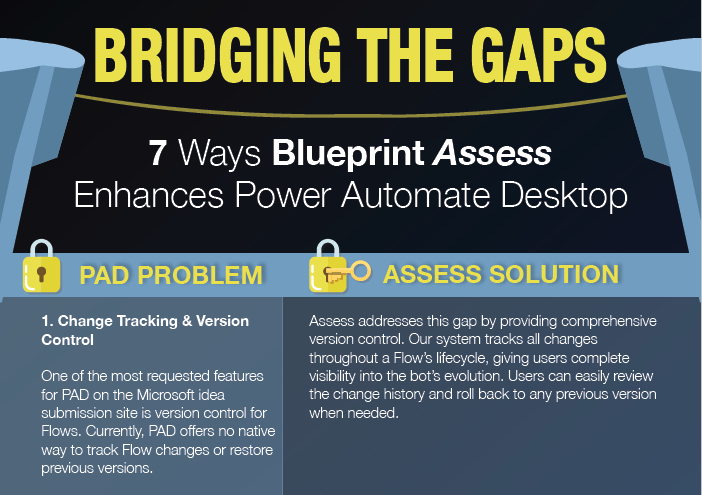3 Critical Components of Process Governance in Automation
To evolve, organizations must move away from the traditional goal of cost reduction and focus on aligning business processes with transformational goals and the customer experience. To do this, organizations must focus on the following three critical areas of process governance – process reengineering, intelligent automation governance, and change management.
1. Business Process Reengineering: It’s Back
To support digital transformation, first you must assess current processes with a strategy to re-engineer before any automation work begins, otherwise you risk automating inefficient processes that will “embalm your current operating model” as one IBM executive describes. To address this challenge, the actions and flow of interrelated processes and technologies should be modeled from discovery through to automation.
Why does business process reengineering matter?
You don’t know what you don’t know - Aside from a few high-profile processes, most organizations can’t describe, nor have they documented, their processes from end-to-end. That’s why before any work actually begins you need to figure out how your organization actually runs. By leveraging process mining and discovery tools you’ll gain a complete view of current-state processes, which is critical for effective reengineering.
Gain additional perspectives - Nobody knows how the business works better than the businesspeople themselves and, as the experts, they need to be included in the reengineering phase. Most process mining and discovery tools have the ability to export a model in a standard BPMN format, which can then be imported into a tool for collaborating on process improvement. This makes it easy to collaborate and gain additional perspectives that will help drive robotic process automation governance goals. This should remain continuous as it promotes effective monitoring and implementation.
Process expertise is critical - The value business process engineering brings to the business is exponential, and it helps organizations meet the requirements of their digital customers because they put the expertise of the process professionals at the forefront. According to a Forrester survey, 29% of respondents plan to increase the role of Lean/Six Sigma to support process improvement and automation as leaders increase their focus on process excellence.
Understand the customer and employee journey - While most process professionals try and align their initiatives with the customer journey, most are not doing so accurately and are rather just focused on automating whatever is in their control. A customer journey is far more than one individual process. It will likely cross multiple organizational boundaries and a number of business systems and processes. Without considering the journey from end-to-end and its interdependencies, teams will likely miss opportunities to re-engineer processes and not meet the requirements of the end-customer.
2. The Need for Intelligent Automation Governance
With so many different automation technologies available today, it can be difficult to discern which are the best fit for your organization. When selecting technologies, you need to consider what role each piece of technology will play and how it will help drive end-to-end automation. Forrester found that organizations will likely need more than one intelligent automation technology to actually drive the desired outcome, which is why it’s absolutely critical to architect these technologies to work together. To do so, you must:
- Define the automation technology requirements - Assess each automation requirement based on the functional capabilities and the effort required to train, deploy, integrate, and govern the solution to determine your need for them.
- Evaluate all intelligent automation technology requirements - Ask yourself and all relevant stakeholders “how will this work in my portfolio?” and make sure that it will help drive end-to-end process automation.
- Consider a pre-integrated solution - A pre-integrated solution may help manage and monitor various levels of process modeling and automation in a seamless manner. For example, Blueprint’s Enterprise Automation Suite makes it easy to capture, design, and manage all business processes within one centralized tool. Its unique process modeling, documentation, tracing, and planning capabilities enable teams to collaborate, improve customer experience, and accelerate the delivery of automation by keeping interdependencies at the forefront.
- Make intelligent automation part of the process governance model - Because the implications of intelligent automation are more far-reaching than a traditional technology initiative, it needs to be a part of the general governance program. The program should include executive sponsorship, organizational change management, customer experience, process excellence, process governance, risk, and compliance.
3. Change Management: Without it, all else fails
In enterprise-scale automation, almost all employees will be involved in driving process improvement and automation. Although this may be difficult to achieve, an effective change management strategy can help bring business users on board to:
- Define existing and reengineered processes - Input from the business stakeholders is critical to driving widescale process reengineering and robotic process automation governance. They can help define the current and desired states of business processes and drive the desired outcome by using process documentation tools to define and refine process definitions.
- Monitor process efficiency and effectiveness - Once processes are redefined and automated, monitoring and refining them becomes a critical part of the businessperson’s role. Ultimately, business stakeholders will need to be trained to use process analytic tools to identify and address potential areas of friction.
- Developing software - As organizations shift towards digital transformation, they must drive incentives, provide training, and make support readily available for the business developer.
Shifting an entire organization from a familiar operating model to one that is focused on embracing a customer-first mindset by driving digital transformation is daunting. To truly achieve this outcome, it’s important to take a step back and plan effectively. You need to understand how your business runs now before you can determine how it will run in the future. Process reengineering is a critical step to getting your process optimized and ready for automation. But remember, robotic process automation governance is a means to an end - to truly reap the benefits you need to effectively govern your intelligent automation technologies and leverage business process experts throughout the automation development lifecycle.
Share this
Recent Stories

Blueprint and Blue Prism Partner to Enable Scale and Governance of RPA

INFOGRAPHIC - Bridging the Gaps: How Blueprint Assess Enhances Power Automate Desktop


